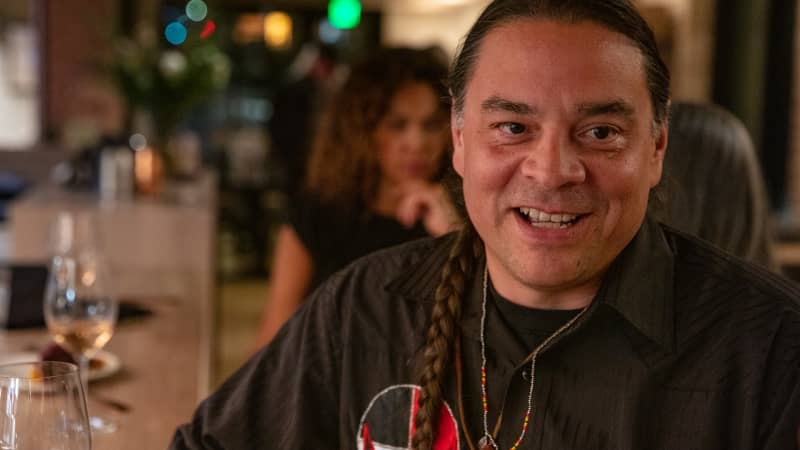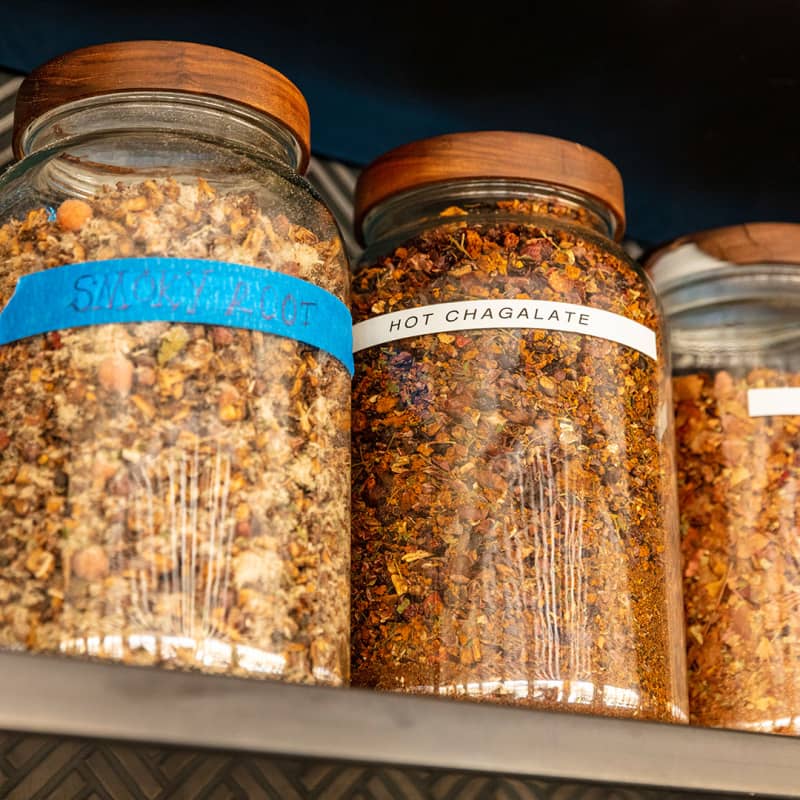Owamni by The Sioux Chef, the modern Indigenous restaurant in downtown Minneapolis, sits along the Mississippi River atop the ruins of an 1800s-era flour mill. Chef and owner Sean Sherman, who is Oglala Lakota from Pine Ridge Reservation in South Dakota, opened Owamni in July of 2021 to promote the foodways of the Ojibwe and Dakota tribes with a menu of precolonial ingredients indigenous to North America.
On the Road with Bryan Roof: Owamni by The Sioux Chef
Published Oct. 9, 2023.

Sign up for the Notes from the Test Kitchen newsletter
Our favorite tips and recipes, enjoyed by 2 million+ subscribers!
The dining room is built with clean lines of blond wood, black steel, and gray brick. Floor-to-ceiling windows overlook the Mississippi River and St. Anthony Falls, a sacred site known as Owámniyomni in Dakota. The bar seating gives diners a view into the heart of the open kitchen where a dozen or so cooks, waiters, and bartenders work in quiet harmony.

Sherman, whose Lakota name is Waŋblí Wathákpe, meaning Charging Eagle, tours me through the restaurant. He points out a map on the wall showing historic waterways, mostly in Minnesota, which he refers to as the “original highways.” The waterways are listed by their Dakota names, which each have a particular meaning. “Usually [they] have something to do with food,” he says. “This is ‘where the fish break,’ or this is ‘where the geese meet.’ Or ‘Rice Lake’ or ‘Potato Lake’ or ‘Onion Lake.’”

As we talk, I dine on smoked trout with tepary-bean spread and wojape, a cooked berry puree; elk tartare with pickled carrots, blueberries, and sumac; a small bowl of roasted crickets and seeds that have the crunch of granola and a rich nuttiness; hand-harvested wild rice—what Sherman refers to as “true wild rice”—with currants and root vegetables; and grilled sweet potatoes drizzled with “indigenous chile crisp,” a dish so simple and perfectly executed that, as a chef, I’m humbled by its genius.
When it comes to understanding and cooking with indigenous foods, Sherman says, “You have to know that you’re not going to find some of these flavors in the grocery store. But if you look outside and learn the plants, you’re going to start to see it. Go outside and learn the names of things and create a relationship. You’re going to start seeing nothing but food and medicine everywhere you look.”

The grounds surrounding Owamni are filled with plants indigenous to the northern Midwest. At the base of each plant is a placard listing its Dakota name first, followed by the English name and description. Sherman talks about this as “passive education.”
He says that a lot of his work has been to “re-understand the pantries in these various areas. What is the indigenous pantry of where we are right here? It’s looking at all this diverse plant growth around us and trying to understand what the Indigenous peoples knew. Food, medicine, crafting, how to harvest, when to harvest, which parts to harvest. All those kinds of pieces, and starting to try to rebuild that education.” Without systems in place to record, steward, and respect this Indigenous knowledge, Sherman fears that it may be lost.

In 2014, drawing on his knowledge of indigenous ingredients, Native dishes, and traditional cooking techniques, Sherman officially began working as “The Sioux Chef,” taking on catering gigs and hosting pop-up dinners, and eventually opening the Tatanka Truck food truck. After winning the bid for the Owamni restaurant space in 2017, Sherman’s popup dinners became more experiential, featuring Native musicians, painters, poets, and singers.
Heading into the kitchen, Sherman points out some of the ingredients the cooks are working with: dandelion pesto; tepary bean succotash; arepas of wild rice and corn; multiple varieties of hard squash that have been pureed, pickled, or roasted; pea shoots; mustard greens; grilled wild mushrooms; sautéed peppers and onions; “shattered” pepitas; hazelnuts; turnips; colorful Pima corn; branches of dried cedar; sprigs of coniferous hemlock (the nonpoisonous varietal). Days ago, they received 40 beavers that will eventually find their way onto the menu.

The crickets I snacked on at the bar are laid out on a baking sheet. Sherman explains that they’re first boiled in a mixture of water and maple syrup and then roasted with salt and chile. “Is that a standard preparation for crickets?” I ask. “That’s just what we came up with,” Sherman says, continuing with a chuckle, “I don’t think there’s a standard for crickets.”
We turn our attention to wild rice, called “manoomin” in Ojibwe, meaning “good berry.” Wild rice holds significant importance to Indigenous people, as Sherman explains, “The Anishinaabe have a legend that when they migrated out west to land here, they were trying to find the place where the ‘food grows on the water,’ meaning this wild rice. They were looking for their homelands. Their whole identity is tied to this piece.” He points out the color variations among the three types of rice laid out before us, and offers up tasting notes for each.

Sherman grabs a small saucepan, adds some of the rice that was hand-harvested by tribal members of White Earth Nation, and fills the pot with just enough water to cover the rice. He throws in a handful of dried white mulberries, a shot each of sunflower oil and maple syrup, a three-finger pinch of salt, and a sprig of coniferous hemlock. He kicks on the stove burner and brings the mixture to a simmer. While it cooks, he adds some raw wild rice to a dry carbon-steel skillet and toasts it over high heat, shaking the pan constantly, until the rice puffs like popcorn. We snack on it while we wait.
The boiled rice cooks in just about 20 minutes, and Sherman notes that true wild rice cooks more quickly and tastes much different than cultivated wild rice, aka paddy rice, which takes about three times as long to cook and has a chewier texture and woodier flavor. This particular true wild rice tastes slightly grassy, with notes of toasted walnut and a gentle smokiness. The hemlock adds a piney flavor, like a cross between fresh sage and juniper, and the mulberries add pops of sweetness. Sherman says when you “taste the rice for what it is, it doesn’t really need anything. It’s got a lot of aroma, it’s got a lot of flavor all by itself.”
About 3 miles across town, inside Midtown Global Market, is Sherman’s research and development space, Indigenous Food Lab (IFL). The space serves as a hub for catering operations and also prepares some of the foundational items for the restaurant, such as tortillas and arepa dough. Eventually the IFL will become a Native market for the community. “There will be a place for people to come and purchase indigenous food products that we curate from Indigenous producers, as well as a small menu where people can order some real grab-and-go kinds of indigenous foods.” (Since this story was reported, the market has opened for business and is thriving.)

Across from the IFL prep area is a small secondary kitchen. “Part of our work is to train more Indigenous entrepreneurs. So people can take over this kitchen and sell and test-market their products to help develop more Indigenous food leaders in the future. We call this the Spirit kitchen,” Sherman says. The space will also be used for cooking demonstrations and shooting educational videos.
About 70 percent of the employees at Owamni and the IFL identify as Indigenous, and Sherman says there are more and more Indigenous chefs cropping up throughout the country. “It’s this movement that’s up-and-coming and it’s been happening for a while. We’ve seen it grow from nothing to now a handful of restaurants across the nation.
“As Indigenous people, so many of us can reconnect with our ancestry, even if it’s broken, and start to rebuild. What is a sense moving forward for us is just reclaiming our true North American foods. The true story of North America.”